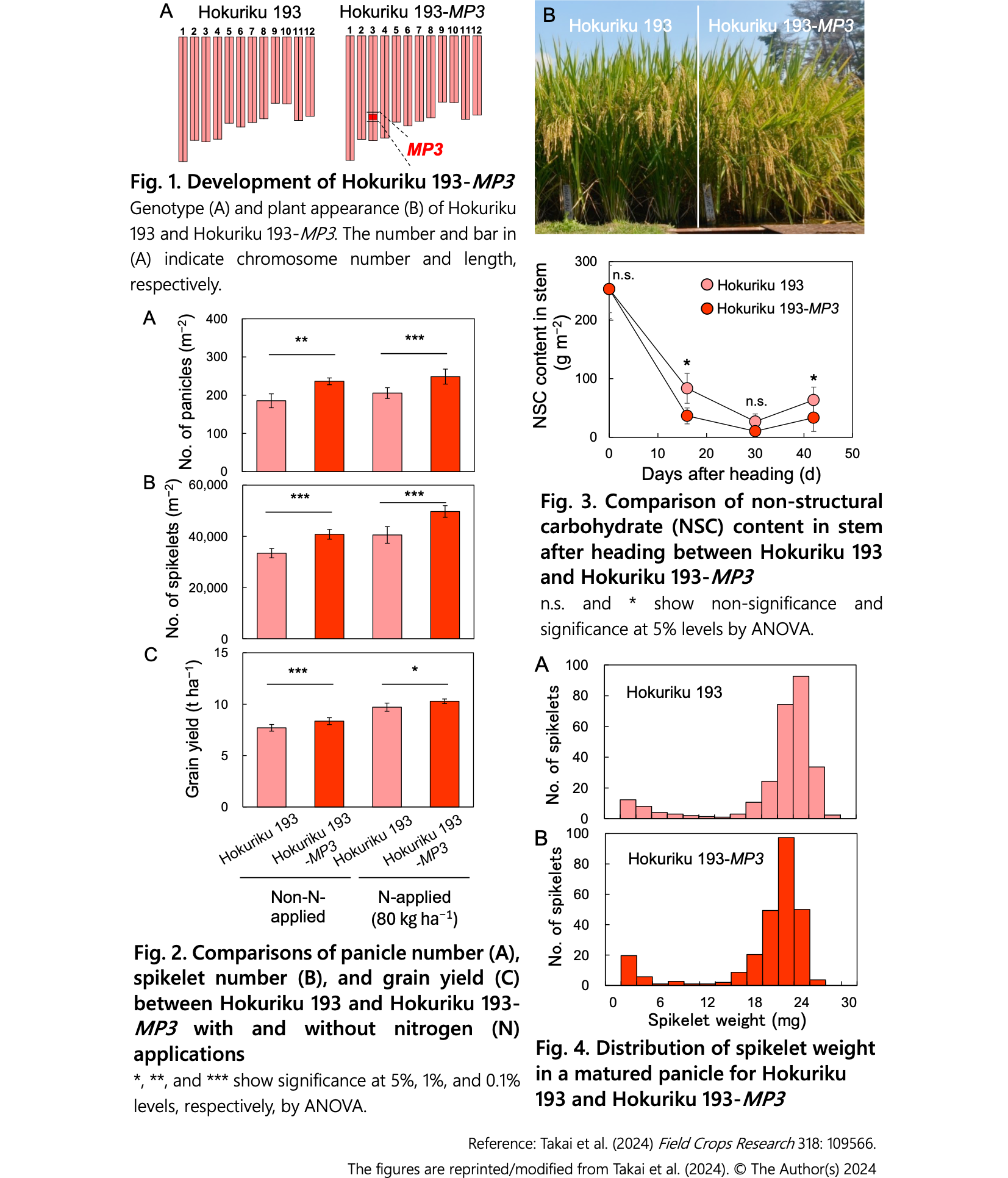A quantitative locus, MP3, which increases panicle number, enhances grain yield in Hokuriku 193, the highest-yielding rice cultivar for livestock in Japan
Description
In recent years, agriculture and livestock in Japan have become increasingly challenging due to global warming as well as rising fertilizer and feed prices caused by changes in international situations. Under these circumstances, the use of highly productive rice is a possible strategy to stabilize farmers' production and profits. Previously, we identified a quantitative locus, MP3, whose Koshihikari allele increased panicle number in the genetic background of indica cultivars. A near-isogenic line (NIL) carrying the Koshihikari allele in the genetic background of the high-yielding indica cultivar Takanari increased panicle and spikelet number, and enhanced grain yield under an elevated atmospheric CO2 environment. However, the NIL did not increase grain yield under an ambient CO2 environment, probably due to its insufficient photosynthetic capacity. On the other hand, another Japanese indica cultivar Hokuriku 193, which recorded Japan’s highest yield of 13 t ha−1, may have the potential to enhance grain yield with MP3 under ambient CO2 environments because it may have surplus photosynthetic ability. The purpose of this study is to develop another NIL carrying MP3 in the Hokuriku 193 genetic background, and elucidate whether MP3 contributes to enhancing grain yield in the Hokuriku 193 genetic background under different nitrogen fertilizer applications.
We can see that Hokuriku 193-MP3, developed from multiple backcrossing of Koshihikari with Hokuriku 193 (Fig. 1A), shows more matured panicles compared to Hokuriku 193 (Fig. 1B). Hokuriku 193-MP3 increases panicle number by 21–28% (Fig. 2A) and spikelet number by 22–23% (Fig. 2B) irrespective of nitrogen applications. Then, it enhances grain yield by 6%, from 9.7 t ha−1 to 10.3 t ha−1 with nitrogen application, and by 8%, from 7.7 t ha−1 to 8.4 t ha−1 without nitrogen application compared to Hokuriku 193 (Fig. 2C). Non-structural carbohydrate (NSC) content in stems is dramatically decreased in Hokuriku 193-MP3 compared to Hokuriku 193 during the initial 2 weeks after heading (Fig. 3), suggesting that more NSC is translocated to panicles in Hokuriku 193-MP3 for promoting the growth of endosperm cells. The percentage of empty spikelets (weighing 6 mg or less) in a panicle is 11% in both Hokuriku 193 and Hokuriku 193-MP3 (Fig. 4), suggesting that Hokuriku 193-MP3 has surplus photosynthetic and translocation abilities that can fill the MP3-increased spikelets.
Since Hokuriku 193-MP3 enhances grain yield even with low nitrogen application, the use of Hokuriku 193-MP3 is expected to contribute to stable rice production for farmers under rising fertilizer prices. Moreover, MP3 is expected to further improve the yield potential of world indica cultivars with high photosynthetic ability equivalent to Hokuriku 193.
Figure, table
- Research project
- Program name
- KAKEN
- Term of research
-
FY2022-2023
- Responsible researcher
-
Takai Toshiyuki ( Crop, Livestock and Environment Division )
Oo Aung Zaw ( Crop, Livestock and Environment Division )
ORCID ID0000-0002-0571-0613KAKEN Researcher No.: 90909772Nakano Hiroshi ( Central Region Agricultural Research Center, NARO )
ORCID ID0000-0002-0564-2550KAKEN Researcher No.: 10414814 - ほか
- Publication, etc.
-
Takai et al. (2024) Field Crops Research 318: 109566.https://doi.org/10.1016/j.fcr.2024.109566
- Japanese PDF
-
2024_B07_ja.pdf1.06 MB
- English PDF
-
2024_B07_en.pdf278.87 KB
* Affiliation at the time of implementation of the study.

